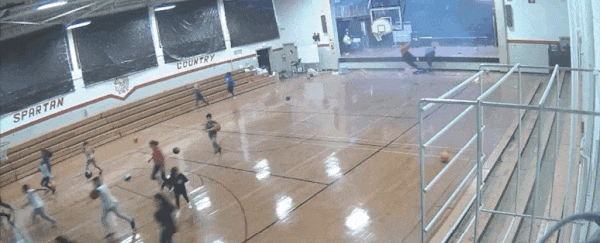It was a stormy Monday afternoon in North Carolina, and 21 students at the Union Intermediate School were huddled in the gymnasium for a 'PE day'. Then, suddenly, and without warning, all hell broke loose.
"We were playing basketball," fifth-grader Chloe Brewer told WRAL Fayetteville, "and it just sounded like something exploded in there."
When the gymnasium's stage crumpled behind them, the students began to flee, and as Chloe tore for the exit, she was hit by something from behind. That's when she heard glass breaking.
The gym's roof and walls had collapsed and caved in, allowing the storm's 85 mile per hour winds (137 kph) to suck plaster, wooden beams, bricks, pipes and glass into the building unimpeded.
"It was just 'bam," principal Dondi Hobbs told local news. "We had no warning. Nobody received any alerts on the phones or anything before we were in action mode."
A camera inside the gymnasium captures the terrifying moment in full.
The National Weather Service has now confirmed the event was caused by a "water-loaded microburst", which sent three students to hospital, Chloe included.
A microburst is similar to a tornado and can cause comparable damage, although it's generally less well-known. These short bursts of extreme weather, usually lasting 5 to 10 minutes, arise from downdrafts of sinking air in a thunderstorm, and when this powerful column of wind eventually hits the ground, it can spread straight-line winds over 100 mph (160 kph).
Wet microbursts, like the one featured above, are less common than dry microbursts, and are usually driven by both plummeting cool air and heavy precipitation, which drags the winds down even faster.
"Cool air is heavier than warm air, so this blob of cold air can plunge toward the ground, and it spreads out rapidly when it hits the ground, kind of like how water explodes sideways when a water balloon is dropped and hits the ground," meteorologist William Gallus told Live Science in 2016.
@NWSRaleigh I caught this on the @WeatherSTEM camera at Carter-Finley. Times out with the damage report NW of Raleigh. pic.twitter.com/oPPDSmcpOI
— Chief Meteorologist Gary Stephenson (@GStephenson_Wx) July 16, 2019
The impact can often seem like a tornado, but the damage these disasters cause appear slightly different. While tornadoes leave behind a circular wave of debris, microbursts tend to cause straight-line damage from the point of impact.
Luckily, in the case of the Union Intermediate School, all three injured students were released from hospital. But if the storm had struck even a day later, an assembly of 450 students would have faced the ferocious brunt of it.
